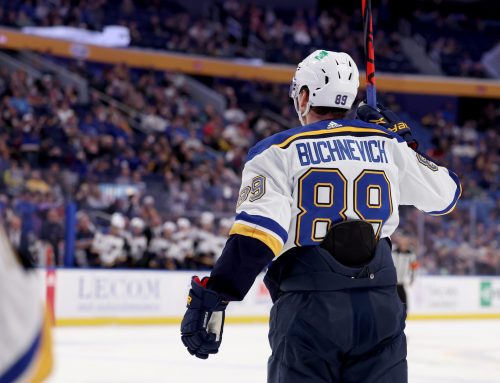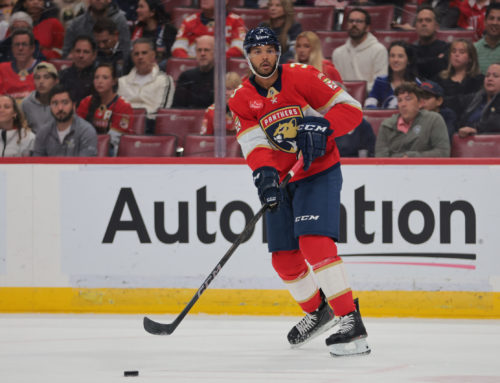
It was always a near-certainty that Joe Thornton would return to the Sharks on a similar deal as last year and he signed on of those Monday afternoon. It’s just a one-year deal with a $5-million cap hit.
Thornton, now 39 years old, is coming off significant knee problems in each of the last two years. You hate to say this might be it, but it’s a wonder how many years he has left given all these issues.
It’ll be curious to see Thornton’s usage. After the acquisition of Evander Kane, the trio of Kane, Joe Pavelski, and Joonas Donskoi was downright dominant in limited ice time together. The duo of Tomas Hertl and Logan Couture seem like a lock to stay together, so will Thornton be used in a lesser role at five-on-five? Or will he be right back to the top line, pushing Donskoi down the lineup? Can Thornton play over 18 minutes a night at this point? Questions without answers just yet.
*
James Neal signed a five-year deal with the Flames. You can read Dobber’s analysis here.
All I’ll say about this for now is that Calgary did a good job bolstering their forward depth (even if it was at the expense of an elite defenceman) but this could be a headache for lineup combinations all year. It seemed like Elias Lindholm was the guy to slot with Johnny Gaudreau and Sean Monahan, and then quotes came out that Matthew Tkachuk might play the right side. Now, throw Neal into the mix. Outside of Monahan/Gaudreau on the top line, and Mikael Backlund centering the second line, I’m not sure if any particular combination is going to be reliable.
*
Well, that was quite the Free Agent Frenzy weekend.
We are still waiting for some significant dominoes to fall. The big name is Erik Karlsson but there is still the possibility of a top winger from the Wild being moved, maybe an offer sheet to someone like Mark Stone (a guy can dream), and there are still some significant free agents that need deals like Calvin de Haan and Rick Nash, though the latter may not even return.
If you missed anything:
- Dobber on the John Tavares signing.
- Ian on the Ryan O’Reilly trade.
- Dobber reviewed July 1st team by team.
- Impacts of all major signings, player by player, can be found here.
Rest assured that we will have other signings and trades as they occur because the NHL GMs are not done yet.
One player I wanted to focus on right now is O’Reilly. Ian does a good job of digging into players impacted but I wanted to expand on one thing he noted about why this helps O’Reilly: better line mates.
Since O’Reilly became a top-line player for Colorado back in 2011-12, he has posted six straight 82-game seasons of at least 55 points. He is one of just 13 players with six straight 55-point seasons, the others are: Patrick Kane, Alex Ovechkin, Jamie Benn, Sidney Crosby, Ryan Getzlaf, Claude Giroux, Phil Kessel, Evgeni Malkin, Joe Pavelski, Tyler Seguin, John Tavares, and Blake Wheeler. Basically, O’Reilly has been among the consistently elite in fantasy production for several years, though without the upside.
Over the last three years, Buffalo has been the lowest-scoring team in the NHL at five-on-five, sitting at 1.84 goals per 60 minutes. The next-closest is New Jersey at 1.95. The difference between Buffalo and St. Louis in that span is about 0.41 goals per 60 minutes. Over three years, that works out to be about one fewer five-on-five goal every three games for Buffalo. Because of time difference spent at five-on-five, in reality it worked out to about 77 fewer goals. It’s a lot, and St. Louis wasn’t even a high-scoring team in that span, sitting near the middle of the league.
I know some may be thinking that it was the Buffalo power play that was their source of scoring, but even with the PP time included, the Sabres still have the second-lowest total goals scored per 60 minutes at 2.35. St. Louis, for comparison, was at 2.68. That difference works out, again, to a goal roughly every three games.
There’s also a pretty big divide within the teams themselves. The 2017-18 Blues didn’t score a lot at five-on-five, coming in 25th in the league in goals for per 60 minutes at 2.25. But within that team that scored 2.25 goals per 60 minutes at five-on-five, Jaden Schwartz and Vladimir Tarasenko were both over 3.10, while Alex Steen was at 2.50. This team also added David Perron. And don’t forget about Robby Fabbri as he was deemed completely healthy and is cleared for training camp. His career points/60 minutes at five-on-five is 1.82, a number higher than every Sabres forward last year (min. 50 games played) not named Jack Eichel.
Once Evander Kane was traded, O’Reilly played a lot of minutes with guys like Scott Wilson and Benoit Pouliot. In fact, he did before that, seeing as his most-common wingers outside of Kane were: Kyle Okposo, Sam Reinhart, Scott Wilson, Benoit Pouliot, and Zemgus Girgensons. Assuming O’Reilly stays in the top-6, he’s looking at playing with Vladimir Tarasenko, Jaden Schwartz, Robby Fabbri, David Perron, or Alex Steen. They also have Jordan Kyrou and Klim Kostin knocking on the door. It’s night and day.
O’Reilly’s fantasy value will come down to role, usage, and power-play time.
Let’s start with usage.
Last year, Brayden Schenn led Blues forwards in TOI per game at 19:44. Schwartz and Tarasenko each cracked 19 minutes. Ryan O’Reilly has played less than 19:44 once in the last five seasons, and it was 19:43 in 2014-15 with the Avs. He played at least 20:49 in three straight years with Buffalo. He averaged over a minute and a half more per game during his Buffalo tenure than the most-used forward last year. And keep in mind that the Blues suffered injuries last year which kept their depth from being effective offensively; their top line playing so much was a factor of chasing a playoff berth while not having a bottom-6 that could contribute offensively. They likely don’t play as much if they’re A) way out of the playoff race or B) healthy and well inside the playoff line.
This is all to say there may be a minute or so coming off O’Reilly’s TOI per game. We could see both he and Schenn around 19 minutes, Tyler Bozak around 15, and the rest is mop-up duty from the fourth line. O’Reilly may improve the quality of his line mates, but the quantity of ice time will decline.
There’s also the question of usage. This tweet was pointed out by Ian in his review of the trade:
Armstrong said that in a perfect world, the #stlblues could get to Christmas and you could have Robert Thomas centering a line with maybe Tarasenko on the right and O'Reilly on the left. Then you have Bozak with Steen & Perron with Schenn/Schwartz. Wrap your head around those.
— Lou Korac (@lkorac10) July 2, 2018
That’s… those are quite imposing lines.
Let’s get the caveats out of the way. As I write this, it’s July 2nd. The team as it is may not even be the team the goes into the season, let alone the composition by Christmas. Maybe Thomas isn’t in the NHL this year (though I think he is, and contributes). This is also what the GM is envisioning in early July; what the coach actually uses in December is another matter.
It’s hard not to imagine O’Reilly being used in a defensive role; top-line assignments when the team has last change as well as a bevy of d-zone draws given his faceoff prowess. My concern is that O’Reilly doesn’t skate with Tarasenko or Schwartz, but rather Steen, Jaskin, or Perron and is used to eat all the tough minutes while allowing Schenn’s line to be a go-between and Bozak’s trio is given the sheltered minutes. That last statement is almost assured.
Not that defensive assignments are anything new to O’Reilly, he’s built a career off them. Just that there is a difference between playing tweener minutes with Tarasenko or playing tough minutes with Perron.
Then there’s the power play. Last year, the trio of Schenn-Schwartz-Tarasenko all managed over three minutes on the PP per game. Alex Steen was a shade under three minutes, Paul Stastny was at 2:44, and the next-highest was Patrik Berglund at 1:43. In other words, there was a clear delineation between a heavily-used top unit, and everyone else.
Schenn, Schwartz, and Tarasenko aren’t going anywhere, so O’Reilly would need to replace Alex Steen. It wouldn’t be a huge leap given their roles on the PP last year. From Hockeyviz.com, we can see Steen had two roles in 2017-18: acting basically as a defenceman or in a net-front position:

O’Reilly didn’t have the exact same role in Buffalo, but it was close. The team had Rasmus Ristolainen manning the blue line, but O’Reilly spent a lot of time around the net:

Simply slotting O’Reilly into Steen’s spot makes a lot of sense here. They can still use Steen as a quarterback for the second PP unit that will get 30 seconds or so every PP, which can help keep his minutes down as he goes into his age-34 season.
So here’s the summary after reviewing the team compositions and contexts:
- The top players for the Blues all played around 14:30 per game at five-on-five last year. That’s about the same amount of ice that O’Reilly received per game in Buffalo.
- The top players for the Blues played at or more than three minutes per game on the power play. O’Reilly clocked in a little over 3:30.
If O’Reilly does lose ice tme, it might be about 20 or so seconds on the power play, and maybe 30 or so seconds at five-on-five. Assuming constant goals-for rates between Buffalo and St. Louis, it would mean a decline of about two or three power-play points and maybe 1-2 five-on-five points. A decline in total ice time of a minute per game may mean four or five fewer points, given constant goals-for rates.
Of course, there won’t be constant goals-for rates. Unless something catastrophic happens, on averages alone, as stated above, O’Reilly will be going to a team that should score at least an extra goal every three games. If he figures in on every four extra goals, that would actually add a couple points to his total from last year.
Finally, there’s the very real possibility that the Blues are among the top offensive teams next year. This team has scoring and playmaking all over the roster with the additions they made, the prospects on their way, and a healthy Robby Fabbri.
O’Reilly has never been much of a roto contributor. Outside of leagues that count faceoff wins, there isn’t much to offer. That means few PIMs, hits, or blocked shots. He has started shooting more in recent seasons and that’s not an aberration; his individual shot attempt rate at five-on-five has climbed two straight years. His value lies in either points-only leagues or leagues that count faceoff wins. But things are looking very bright indeed. He should be able to at least replicate his 2017-18 season provided he plays 80 games, and has a realistic chance of cracking 70 points for the first time in his career.





 FLA
FLA TOR
TOR CAR
CAR WPG
WPG DAL
DAL EDM
EDM BUF
BUF WSH
WSH
